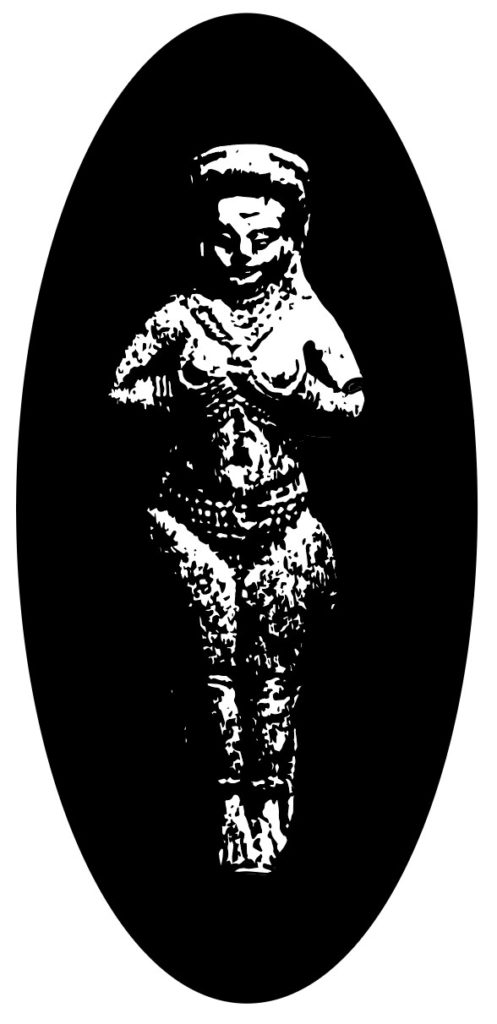Bilateral symmetry – the condition where the organism’s left and right sides are approximate mirror images of each other – is manifest in over 99% of animal species on Earth. Algae, sponges and the like make an exception with radial symmetry and other more amorphous features. A curious half-way oddity is the starfish, whose adults have five-fold symmetry, but whose larvae are bilaterally symmetric.

Considering the fact most living creatures, including ourselves, feature symmetric appearance, our particular sensitivity to recognising symmetrical forms should come as no surprise. A specific part of the brain, the fusifom face area (FFA), located in the bottom of the brain is specialised for facial recognition, responsible for identifying potentially hundreds of faces from minuscule details, including aberrations from perfect symmetry that make our physical features unique. Besides recognising fellow symmetrical creatures as they appear to us, we also easily see faces and entities where there actually are none.1
Finding symmetry and spotting ephemeral entities in visual abstractions (whether in nature, art or everyday life) seems instantly pleasing or gratifying to the perceiver. Symmetry is seen as beautiful, and symmetrical facial features are considered attractive. The process of form and pattern recognition seems to be linked with pleasure centres in the brain. Some studies suggest there’s a reward system for finding signals among noise encoded in the brain.
Repeated serial triggering of the symmetry recognition process has the potential to bring about a low level hypnotic state of awareness, which can be further enhanced by tuning the external in internal properties of the situation. Externally by minimizing distractions from the immediate environment, internally by the subject entering a more suggestive state of consciousness which can be achieved by various means – from relaxation and meditation practises to the use of psychoactive substances, especially those of the tryptamine variety (Psilocybin, DMT, LSD).

In the field of psychology, the symmetrical images were employed by Hermann Rorschach with his famous Rorschach images. He developed a series of cards featuring these images as a psychoanalytic experiment, figuring that different personalities would see things differently. The Rorschach images are based on the technique known as Klecksography, the invention of which is often attributed to writer and physician Justinus Kerner but the real origins remain probably untraceable (a similar children’s game was popular in Switzerland at the time). Random spots of ink are dropped onto paper, the paper is folded in half so that the ink spreads and forms a mirror reflection when the paper is unfolded. Rorschach himself is said to have been fascinated with klecksography as a child, to the point he received the nickname Klecks from his schoolmates.2
Rorschach inspired the art world, too, perhaps most famously Andy Warhol, who mistakenly thought that patients created the inkblot images for doctors to decipher. Interestingly, Warhol’s Rorschach series of paintings is one of the few in which he didn’t rely on preexisting images.3
“Liquid, protean and seductively vacant, they reflect your own desires and fantasies right back at you. Conceived in the spirit of superstar Nico’s beguiling promise (“I’ll be your mirror”), these pictures will be whatever you want them to be.”4

In fine arts, symmetry has been both favoured (as aesthetic, beautiful) and rejected (as simple, easy, naive), depending on the prevalent aesthetic and conceptual affinities of the given era. Symmetry as a compositional choice is harmonic, static, rather obvious and not that challenging nor interesting in itself. However, introducing symmetrical elements in non-figurative imagery begins to bring about something worthwhile since it provokes the viewer’s symmetry recognition system. Perfect symmetry in abstraction is somewhat predictable, as in the Rorschach test images for example. It is rather the vague border area where recognizable things begin to emerge from “noise” that is of interest to me, especially in moving image when the imagery fluctuates back and forth between pure abstraction and something recognizable. Such imagery has the potential to introduce a slightly altered state of awareness where the analytical processes of the conscious mind are put aside and we may let some things emerge from deeper levels of consciousness. Experimentation in this border area is where my personal interest in exploring symmetry (and degrees of aberrations thereof) lies in case of The Unfolding.
On Image
Symmetry in moving image is technically easy to achieve in digital video editing with a simple mirror effect present in most video editing software. However, such an effect produces precise and predictable results; although it looks slick it instantly feels rather dull – as seen more recently in the title sequences of several tv series (Dark, Hemlock Grove and La Treve off the top of my mind).
My approach with The Unfolding was to create something more organic, mercurial and indeterminate, so I began experimenting with the properties of light when it’s being reflected, redirected and bent dynamically, enhanced with old-school methods of montage and multiple exposure. The symmetry wasn’t originally planned5 but happened as a side-effect after which I decided to explore and develop it further.
In retrospect, one piece from the film era which I feel The Unfolding bears some kinship to is the experimental film / audiovisual piece Burning Water by The Anti Group aka TAGC. Made in around 1986-1989, Adi Newton and Robert E. Baker filmed footage of natural phenomena (flowing water, flames etc) through a specially constructed mirror lens apparatus and also digitally processed the footage afterwards (probably with an Amiga 20006, state-of-the-art computer tech at the time) and came up with material that, in Newton’s own words “relates directly to the subconscious levels of the mind, a kinetic Rorschach-test“7. I recognize the parallel streaks in aesthetic and conceptual intentions (and yet notice the many differences), and although it wasn’t consciously in my mind while working on the piece I think in some ways The Unfolding pays homage to Burning Water (which I consider a masterpiece shown way too seldom.)8
In the klecksographic process, the final image remains in a latent state until the paper is unfolded. As such it is like an undeveloped film, or an event waiting to be witnessed. Similarly The Unfolding remains latent as digital information, until projected becomes a continuously unfolding kinetic image, a living negative Rorschach image painted with light (instead of ink).
In suitably prepared setting, The Unfolding acts as a powerful ‘mind mirror’, calling the subconsious of the perceiver to surface and overtake the processing of visual and audible information. Installed in a darkened space, and combined with a soundtrack prepared with particular structures and frequencies, the work enables the perceiver to achieve an subtly altered state of consciousness. The perceiver’s preparedness plays a critical role in the process: one is required to let down defenses of analytical thinking.
A reporter described the piece, “like a micro universe emerging one after another, over and over.”9
The Unfolding also relates to scrying – the act of gazing into into a crystal to obtain visions from other plains of existence normally unseen – a central practice in the traditions of Western ceremonial magick from John Dee & Edward Kelley10 to Aleister Crowley & Victor Neuburg11. However, the ‘crystal’ in our case is the projection of light on the wall in a dark space.
On Sound
The Unfolding does not have one fixed soundtrack. On the occasions the installation has been presented, the soundtrack has been reimagined and re-recorded from a number of basic premises. The underlying inspiration comes from long-form atonal sound works, primarily early drone music (LaMonte Young, Tony Conrad) and Tibetan ritual music. My sonic practice in the recent years is mostly based on field recordings and random radio samples, resampled, treated and processed until the sources vanish and some other things begin to emerge. Again, the border area between pure abstraction and something recognisable is the field being explored.
The soundtracks, and various derivations thereof, have been recorded in studio live sessions. A selection of these recordings forms the related music album The Unfolding – Themes & Variations.

What Things May Emerge
The installation’s duration and contents vary depending on the settings of each instance of presentation. On average, there are about 30 000 still images (individual frames). While it goes beside the point of the installation to isolate and inspect individual frames, I nevertheless choose to take this route here, as it may potentially lead to new works yet unexplored. (Editor’s note: see The Unfolding – Filmic Superimpositions for a selection of print works that emerged from here…)
Browsing through the thread of individual frames of the film I often stop to look deeper into a particular frame whenever something grabs my attention. Pareidolia put to good use. Sometimes, interesting figures emerge, half-formed entities or facial characteristics; apparitions of some kind. I’ve isolated individual frames from the footage and printed some of them out to for further use as lithographic plates. In the process the emerging figures may develop further to gain more refined characteristics, although sometimes what was initially there evaporates – signal descends back into the noise it seemed to emerge from.
A particular frame-print was chosen for the front cover of the album. This is because it strongly reminded me of an ancient figure(s) of the goddess Inanna who has played a central role in my personal cosmography since 1992. In this frame12 I see a winged, feminine figure in process of making a hand gesture that resembles the Sign of Pan or Bacchus (7°=4). The Sign of Pan is the central letter ‘O’ in the N.O.X. signs – NOX being the Night or Darkness (counterpart of LVX, Light), we are directly reminded of Inanna’s descent into the Underworld as told in Gilgamesh.
Fellow travellers who have experienced periodical depression may approve my choice of refering to these periods as descents into the Underworld. Or, seasons in the Abyss. The process brings illumination through darkness: a realization that that which is perceived to be separate is understood to be united.
Again, we return to the ground premises of the installation piece. A projection of kinetic light in a darkened space, aim of inner contemplation, potentially bringing unconscious issues to surface – fears and desires as emerging forms perceived.
— Niko Skorpio

This article was first published in the ‘Research Document’ booklet that came with the limited research edition of The Unfolding – Themes & Variations CD by Niko Skorpio (PARAFERAL Sound, PFS1906X).
Notes
- Pareidolia: perception of figurative images in random visual stimuli; a visual type of… Apophenia: tendency to find signal in noise, patterns in random information, ie. find meaning where there apparently is none.
- Blinderman, Ilia, “Hermann Rorschach’s Original Rorschach Test: What Do You See?”, http://www.openculture.com/2013/11/take-hermann-rorschachs-original-rorschach-test-1921.html
- “Rorschach – Andy Warhol”, https://www.thebroad.org/art/andy-warhol/rorschach
- Fineman, Mia, “Andy Warhol: Rorschach Paintings”, Artnet,
http://www.artnet.com/Magazine/features/fineman/fineman10-15-96.asp - see another text called Towards the Unfolding for a percursor and a starting point.
- White, Rupert, “Adi Newton on Pataphysics, ClockDVA, Electronic Music and Sheffield”, Artcornwall.org, http://www.artcornwall.org/interviews/Adi_Newton_.htm
- Newton, Adi, “Burning Water”, https://theantigroup.wordpress.com/2010/01/31/burning-water/
- T.A.G.C. Burning Water (excerpt) https://www.youtube.com/watch?v=PUVaGJ-0DkE
- A review in Kaarinalehti XX/2018.
- see Casaubon, A True & Faithful Relation of What passed for many Yeers…
- see Crowley, The Vision and the Voice
- See centerfold for a graphic print variation of the frame


1 thought on “Reflections on Bilateral Symmetry and some Other Things”